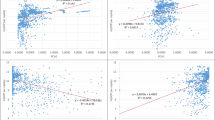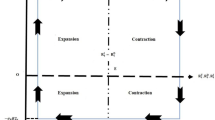Abstract
This study examines the impacts of national innovation systems (NIS) and economic complexity index (ECI) on economic growth. A composite index of NIS is developed by using US patent data as a weighted sum of three, four or five variables among the following: concentration of assignees, localization, originality, diversification, and cycle time of technologies. Growth regressions confirm the significant and robust impacts of NIS3a, NIS4a, and NIS5 indices on economic growth. The common feature of these NIS indices is that they have the same component variables as their ingredients, and these are originality, cycle time, and technological diversification. NIS3a is the most parsimonious and powerful among all indices. The robustness of ECI is questionable because ECI loses significance after adding government expenditure and terms of trade variables into the regression model. Results confirm the overall importance of NIS in economic growth and justify policy efforts to improve NIS. This research is one of the first to generate a robust NIS index by using patent data only without many data requirements and free from the problem of cross-country comparability of underlying variables.
Access this chapter
Tax calculation will be finalised at checkout
Purchases are for personal use only
Similar content being viewed by others
Change history
08 September 2022
The book was inadvertently published with its Chapters 6, 7, 10, 11, 12, 14, 16 having an incorrect “Copyright Holder Name” and “Copyright Year” information. The reprinting information in the footnotes of these Spin-Off chapters were also missed to be included to these 7 chapters.
Notes
- 1.
- 2.
We follow Acemoglu et al. (2001) in not adding the variable of initial per capita income in the regression models. However, the results do not change with and without this variable.
References
Abramovitz M (1986) Catching up, forging ahead, and falling behind. J Econ Hist 46:385–406
Acemoglu D, Johnson S, Robinson JA (2001) The colonial origins of comparative development: an empirical investigation. AER 91:1369–1401
Aghion P, Howitt P (1992) A model of growth through creative destruction. ECTA 60:323–351
Archibugi D, Coco A (2004) A new indicator of technological capabilities for developed and developing countries (ArCo). WD 32:629–654
Arellano M, Bover O (1995) Another look at the instrumental variable estimation of error-components models. J Econ 68:29–51
Barro RJ (2003) Determinants of economic growth in a panel of countries. Ann Econ Financ 4:231–274
Castellacci F (2008) Technological paradigms, regimes and trajectories: manufacturing and service industries in a new taxonomy of sectoral patterns of innovation. Res Policy 37:978–994
Castellacci F (2011) Closing the technology gap? Rev Dev Econ 15:180–197
Castellacci F, Natera JM (2015) The convergence paradox: the global evolution of national innovation systems. In: Archibugi D, Filippetti A (eds) The handbook of global science, technology, and innovation. Wiley Blackwell, Chichester
Charnes A, Cooper WW, Rhodes E (1978) Measuring the efficiency of decision making units. Eur J Oper Res 2:429–444
Coe NM, Hess M, HWc Y, Dicken P, Henderson J (2004) ‘Globalizing’ regional development: a global production networks perspective. T I Brit Geogr 29:468–484
Cohen WM, Levinthal DA (1990) Absorptive capacity: a new perspective on learning and innovation. Adm Sci Q 35:128–152
Colombage, S (2016) A grounded demolition of Richard Hausmann’s economic thinking for Lanka. Thuppahi’s Blog. https://thuppahi.wordpress.com/2016/01/27/a-grounded-demolition-of-richard-hausmanns-economic-thinking-for-lanka/. Access 27 November 2016
Cornell University, INSEAD, WIPO (2018) The global innovation index 2018: energizing the world with innovation. Ithaca, Fontainebleau, and Geneva
Desai M, Fukuda-Parr S, Johansson C, Sagasti F (2002) Measuring the technology achievement of nations and the capacity to participate in the network age. J Hum Dev Capabil 3:95-122
Dosi, G, Pavitt K, Soete L (1990) The economics of technical change and international trade. LEM Book Series
Dosi M, Fukuda-Parr S, Johansson C, Sagasti F (2002) Measuring the technology achievement of nations and the capacity to participate in the network age. J Hum Dev 3:95–122
Edquist C (1997) Systems of innovation approaches: their emergence and characteristics. In: Edquist C (ed) Systems of Innovation: technologies, institutions and organizations. Pinter/Cassell, London
European Commission (2018) European innovation scoreboard. Publications Office of the European Union, Luxembourg
Fagerberg J (1987) A technology gap approach to why growth rates differ. Res Policy 16:87–99
Fagerberg J (1988) International competitiveness. EJ 98:355–374
Fagerberg J, Godinho M (2004) Innovation and catching-up. In: Fagerberg J, Mowery D (eds) The Oxford handbook of innovation. Oxford University Press, Oxford
Fagerberg J, Srholec M (2008) National innovation systems, capabilities and economic development. Res Policy 37:1417–1435
Fagerberg J, Verspagen B (2002) Technology-gaps, innovation-diffusion and transformation: an evolutionary interpretation. Res Policy 31:1291–1304
Fidrmuc J (2004) Migration and regional adjustment to asymmetric shocks in transition economies. J Comp Econ 32:230–247
Filippetti A, Peyrache A (2011) The patterns of technological capabilities of countries: a dual approach using composite indicators and data envelopment analysis. WD 39:1108–1121
Freeman C, Clark J, Soete L (1982) Unemployment and technical innovation. Frances Pinter, London
Furman JL, Porter ME, Stern S (2002) The determinants of national innovative capacity. Res Policy 31:899–933
Gerschenkron A (1962) Economic backwardness in historical perspective: a book of essays. Harvard University Press, Cambridge
Hall, BH, Jaffe AB, Trajtenberg M (2001) The NBER patent citation data file: lessons, insights and methodological tools. NBER discussion paper series, 3094
Hanson GH, Mataloni RJ Jr, Slaughter MJ (2005) Vertical production networks in multinational firms. REStat 87:664–678
Hausmann R, Hidalgo CA, Bustos S, Coscia M, Chung S, Jimenez H, Simoes A, Yildirim MA (2011) The atlas of economic complexity: mapping paths to prosperity. MIT Press, Cambridge
Hausmann R, Hidalgo CA, Bustos S, Coscia M, Simoes A, Yildirim MA (2014) The atlas of economic complexity: mapping paths to prosperity. MIT Press, Cambridge
Hotelling H (1933) Analysis of a complex of statistical variables into principal components. J Educ Psychol 24:417
Inoua, S (2016) A simple measure of economic complexity. arXiv preprint arXiv:1601.05012
Jaffe AB, Trajtenberg M (2002) Patents, citations, and innovations: A window on the knowledge economy. MIT press, Cambridge
Jaffe AB, Trajtenberg M, Henderson R (1993) Geographic localization of knowledge spillovers as evidenced by patent citations. QJE 108:577–598
Kim YK, Lee K (2015) Different Impacts of Scientific & Technological Knowledge on Economic Growth: Contrasting S&T Policy in East Asia and Latin America. Asian Econ Policy R 10:43-66
Lee K (2013) Schumpeterian analysis of economic catch-up: knowledge, path-creation, and the middle-income trap. Cambridge University Press, Cambridge
Lee K, Kim B-Y (2009) Both institutions and policies matter but differently for different income groups of countries: determinants of long-run economic growth revisited. WD 37:533–549
Lucas RE Jr (1988) On the mechanics of economic development. J Monet Econ 22:3–42
Lundvall B-Å (1992) National systems of innovation: toward a theory of innovation and interactive learning. Anthem Press, London
Malerba F (2005) Sectoral systems of innovation: a framework for linking innovation to the knowledge base, structure and dynamics of sectors. Econ Innovat New Tech 14:63-82
Mankiw NG, Romer D, Weil DN (1992) A contribution to the empirics of economic growth. QJE 107:407–437
Marshall MG, Gurr TR, Jaggers K (2017) Polity IV project: Political regime characteristics and transitions, 1800-2016. Center for Systemic Peace
Melyn, W, Moesen W (1991) Towards a synthetic indicator of macroeconomic performance: unequal weighting when limited information is available. K.U. Leuven Public Economics Research Papers 17
Nardo, M, Saisana M, Saltelli A, Tarantola S, Hoffman A, Giovannini E (2005) Handbook on constructing composite indicators. OECD Statistics Working Papers 03
Nelson RR (1993) National Innovation Systems: a comparative analysis. Oxford University Press, Oxford
Ohkawa K, Rosovsky H (1973) Japanese economic growth: trend acceleration in the twentieth century. Stanford University Press, Stanford
Orefice G, Rocha N (2014) Deep integration and production networks: an empirical analysis. World Econ 37:106–136
Palmer J, Richards I (1999) Get knetted: network behaviour in the new economy. J Knowl Manag 3:191–202
Pearson K (1901) LIII. On lines and planes of closest fit to systems of points in space. Lond.Edinb.Dubl.Phil.Mag. 2:559–572
Romer PM (1990) Endogenous technological change. J Polit Econ 98:S71–S102
Sala-i-Martin XX (1997) I just ran four million regressions. AER 87:178-183
Schölkopf B, Smola A, Müller KR (1997) Kernel principal component analysis. In International Conference on Artificial Neural Networks. Springer, Berlin Heidelberg, pp.583-588
Schumpeter JA (1934) The theory of economic development. Harvard University press, Cambridge
Solow RM (1956) A contribution to the theory of economic growth. Q J Econ 70:65-94
Toya H, Skidmore M (2007) Economic development and the impacts of natural disasters. Econ Lett 94:20–25
Trajtenberg M, Henderson R, Jaffe A (1997) University versus corporate patents: a window on the basicness of invention. Econ Innov New Technol 5:19–50
USPTO (1976-2017) Patent Grant Red Book (Full Text)
Verspagen B (1991) A new empirical approach to catching up or falling behind. Struct Chang Econ Dyn 2
World Bank (2017) World development indicators. The World Bank
Author information
Authors and Affiliations
Corresponding author
Editor information
Editors and Affiliations
Appendix
Appendix
Rights and permissions
Copyright information
© 2019 Springer-Verlag GmbH Germany, part of Springer Nature
About this chapter
Cite this chapter
Lee, K., Lee, J. (2019). National innovation systems, economic complexity, and economic growth: country panel analysis using the US patent data. In: Pyka, A., Lee, K. (eds) Innovation, Catch-up and Sustainable Development. Economic Complexity and Evolution. Springer, Cham. https://doi.org/10.1007/978-3-030-84931-3_6
Download citation
DOI: https://doi.org/10.1007/978-3-030-84931-3_6
Published:
Publisher Name: Springer, Cham
Print ISBN: 978-3-030-84930-6
Online ISBN: 978-3-030-84931-3
eBook Packages: Economics and FinanceEconomics and Finance (R0)




